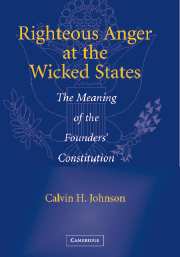Book contents
- Frontmatter
- Contents
- Acknowledgments
- Frequently Cited Sources
- Introduction
- PART ONE THE NECESSITY OF THE CONSTITUTION
- 1 The Rise of the Righteous Anger
- 2 Madison's Vision: Requisitions and Rights
- 3 The Superiority of the Extended Republic
- 4 Shifting the Foundations from the States to the People
- 5 Partial Losses
- 6 Anti-Federalism
- 7 False Issues: Bill of Rights, Democracy, and Slavery
- PART TWO LESS CONVINCING FACTORS
- PART III THE SPLIT AND THE END OF THE CONSTITUTIONAL MOVEMENT
- Concluding Summary
- Index
4 - Shifting the Foundations from the States to the People
Published online by Cambridge University Press: 27 July 2009
- Frontmatter
- Contents
- Acknowledgments
- Frequently Cited Sources
- Introduction
- PART ONE THE NECESSITY OF THE CONSTITUTION
- 1 The Rise of the Righteous Anger
- 2 Madison's Vision: Requisitions and Rights
- 3 The Superiority of the Extended Republic
- 4 Shifting the Foundations from the States to the People
- 5 Partial Losses
- 6 Anti-Federalism
- 7 False Issues: Bill of Rights, Democracy, and Slavery
- PART TWO LESS CONVINCING FACTORS
- PART III THE SPLIT AND THE END OF THE CONSTITUTIONAL MOVEMENT
- Concluding Summary
- Index
Summary
THE STEP-BY-STEP REVOLUTION
The new Constitution created a national government supreme over the states on a foundation of sovereignty of the people. The new government, the French reported home, would no longer need the consent of the states for any of it operations. “The necessity of having a government which should at once operate upon the people, and not upon the states,” Pinckney told South Carolina, “was conceived to be indispensable by every delegation present” at the Philadelphia Convention. Madison described the new Constitution to Jefferson saying that the Philadelphia Convention had adopted “the alternative of a government which instead of operating, on the States, should operate without their intervention on the individuals composing them.” Jefferson responded that he liked the idea of a Congress that should go on of itself peaceably, “without needing continual recurrence to the state legislatures.” The new federal government, Jefferson wrote, would “walk upon its own legs.”
The core idea of forming an independent, complete government on the national level was accomplished early in the Convention at Philadelphia and stuck. On May 30, 1787, the fourth day of a quorum, the convention passed a resolution, derived from the Virginia Plan, stating “that a national governt. ought to be established consisting of a supreme Legislative Executive & Judiciary.” The Convention went on for another three and half months, but the most important issues in Philadelphia were settled without compromise on that day when the Virginia Plan was endorsed.
- Type
- Chapter
- Information
- Righteous Anger at the Wicked StatesThe Meaning of the Founders' Constitution, pp. 74 - 99Publisher: Cambridge University PressPrint publication year: 2005

